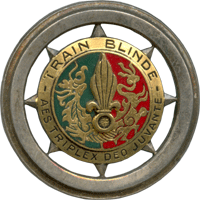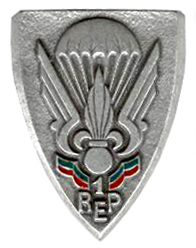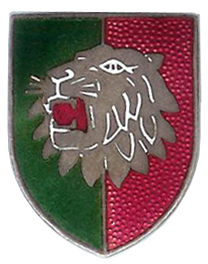 W
WThe 2nd Foreign Cavalry Regiment was a foreign cavalry regiment of the Foreign Legion. While the regiment was dissolved twice in 1946 and 1962; the regimental colors have been entrusted by the Foreign Legion Detachment in Mayotte since 1984.
 W
WThe Garibaldi Legion or officially the 4th Marching Regiment of the 1st Foreign Regiment was a unit of the French Foreign Legion which formed the Marching Regiment of the Foreign Legion composed entirely of Italian citizens, who fought in France in World War I against the Germans and existing ephemerally from the end of 1914 to 1915. After having distinguished themselves at Argonne in December 1914, the regiment was finally dissolved on March 5, 1915, due to Italy's entry in the war and the departure of the majority of the regiment back to their country of origin.
 W
WThe 12th Foreign Infantry Regiment was an infantry regiment of the French Foreign Legion which existed from 1939 to 1940 at the beginning of World War II.
The 21st Marching Regiment of Foreign Volunteers was a formation of the French Foreign Legion from 1939 to June 26, 1940.
 W
WThe Armoured Train of the Foreign Legion was an Armoured train detachment of the French Foreign Legion formed in Tonkin. In 1948, the 2nd Foreign Regiment 2e RE, formed one, then two armoured trains to protect convoys from attack by the Vietminh, protect the Transindochinois Line and support the Army along the rail line. During this military campaign, the Legion formed several armoured trains, which were mounted by the 1st Foreign Cavalry Regiment 1er REC and other Legion units.
 W
WThe Communal Depot of the Foreign Regiments (DCRE), or, was the primary training formation of the French Foreign Legion from 1933 to 1955.
 W
WEnrollment of Czechoslovak volunteers in the French Foreign Legion started in Paris on 21 August 1914. The 1st Company, Battalion C, of the 2nd Infantry Regiment of the Foreign Legion, was created in Bayonne on 31 August. Meeting in the city, the soldiers greeted each other with "Na zdar!" and hence came to be called "Nazdar!" Company. The company was part of the French army's Moroccan division, and took part in heavy combat during assaults near Arras on 9 May and 16 June 1915, where it suffered heavy casualties. Because of these, Battalion C, including "Nazdar!" Company, was disbanded, and volunteers continued to fight in various French army and Foreign Legion units.
 W
WThe Foreign Air Supply Company (C.E.R.A) was an air supply unit of the French Foreign Legion.
The 11th Foreign Infantry Regiment was a regiment of the French Foreign Legion which served during World War II from 1939 to 1940.
 W
WThe 5th Foreign Infantry Regiment, nicknamed the "Regiment of Tonkin", was a regiment of the French Foreign Legion created under the Third Republic, and dissolved in 2000. The history of this regiment is marked by participation in World War II, the Indochina War and the Algerian War.
 W
WThe 6th Foreign Infantry Regiment was an infantry regiment of the French Foreign Legion from 1939 to 1941 and again from 1949 to 1955.
The 22nd Marching Regiment of Foreign Volunteers was a regiment of the French Foreign Legion formed from expatriates living in France at the outbreak of World War II. While established as a different unit, its veterans are recognized as part of the Foreign Legion.
The Marching Regiments of Foreign Volunteers were temporary formations of the French Foreign Legion organized from Foreign volunteers during World War II. These regiments were formed on 16 September 1939: On September 16, 1939, the war minister decided to form special corps of foreign volunteers part of the Foreign Legion. They were part of the Marching Regiments of Foreign Volunteers.
 W
WThe 1st Foreign Parachute Battalion was a foreign parachute battalion of the French Foreign Legion formed from the Parachute Company of the 3rd Foreign Infantry Regiment.
 W
WThe 2nd Foreign Parachute Battalion was a foreign parachute battalion of the French Foreign Legion initially composed of volunteers of the 4th Demi-Brigade of the Foreign Legion.
 W
WThe 3rd Foreign Parachute Battalion was foreign parachute battalion of the French Foreign Legion formed based on the Parachute Instruction Company (C.I.P) of the 7th combat company of the 2nd Battalion of the 1st Foreign Infantry Regiment.
 W
WThe Parachute Company of the 3rd Foreign Infantry Regiment was a foreign paratrooper company formed from the 3rd Foreign Infantry Regiment of the French Foreign Legion.
 W
WThe 1st Foreign Parachute Heavy Mortar Company was an ephemeral foreign airborne heavy mortar company of the French Foreign Legion which fought during the First Indochina War at the corps of the French Far East Expeditionary Corps.
 W
WThe 3rd Foreign Parachute Regiment was a foreign parachute regiment of the French Foreign Legion and previous 3rd Foreign Parachute Battalion, from September 1, 1955, to December 1, 1955.
 W
WThe 1st Foreign Parachute Regiment was an airborne regiment of the French Foreign Legion which dated its origins to 1948. The regiment fought in the First Indochina War as the three-time reconstituted 1st Foreign Parachute Battalion, the Suez Crisis and Algerian War, but was dissolved along with the 10th Parachute Division and 25th Parachute Division following the generals' putsch against part of the French government in 1961.
 W
WThe Passage Company of the Foreign Legion of Saigon was a logistics based operation handling of the French Foreign Legion, in Cochinchina, and based at fort de Cay May. In 1950, the CPLE of Saigon counted 21,389 passengers of all ranks, the company also registered 14 tons of baggage and almost 125,000 letters transmitted.
 W
WThe 97th Reconnaissance Group of the Infantry Division was a motorized cavalry unit composed of members of the French Foreign Legion which existed briefly at the beginning of the Second World War. The unit was involved in the Battle of France until France's surrender to Germany; the 97th GRDI remained intact for a few months after the surrender until it was disbanded on September 30, 1940.